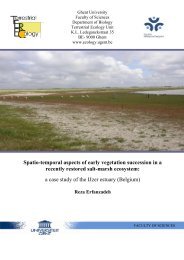PhD Arthur Decae 2010 - Ghent Ecology - Universiteit Gent
PhD Arthur Decae 2010 - Ghent Ecology - Universiteit Gent
PhD Arthur Decae 2010 - Ghent Ecology - Universiteit Gent
Create successful ePaper yourself
Turn your PDF publications into a flip-book with our unique Google optimized e-Paper software.
Distribution of species. Although our knowledge on species distribution in the Iberian<br />
Peninsula is rapidly growing, it is still far from complete. This is especially true for taxa, such<br />
as the Nemesiidae, that contain a large number of endemics that usually are very restricted<br />
in space (Melic 2001). A way of trying to overcome this impediment is to use ecological<br />
niche modelling. Using confirmed and georeferenced data on the one hand, and data on<br />
climatic variables in space on the other, it is possible to infer the potential distribution ranges<br />
of species. Most of the existing techniques try to determine the range of environmental<br />
variables in which the species is known to exist and extrapolate the known distribution to sites<br />
where the species has not actually been found, but where environmental conditions are similar<br />
to the ones found in the known area of distribution (e.g. Segurado & Araújo 2004, Elith et al.<br />
2006). This bioclimatic envelope, when transferred to a spatial analysis tool, is reflected in a<br />
map with the potential distribution of the species. The potential distribution is a measure of<br />
adequacy of the area suitable to the species, taking the climatic variables into account. From<br />
all the options available, some require both presence and absence data and others rely on<br />
presence data alone. Given that absence data are usually very hard to obtain for spiders<br />
(and most invertebrates) our options are somewhat restricted. We have chosen to use the<br />
DOMAIN method (Carpenter et al. 1993) for a number of reasons: (1) it uses presence-only<br />
data; (2) it is one of the best methods overall, usually as efficient as more complex methods<br />
(e.g. Elith et al. 2006; Hernandez et al. 2006); (3) it is simple to use and moreover<br />
implemented in free GIS software (http://www.diva-gis.org); (4) its results are easily<br />
amenable to expert knowledge scrutiny. Expert knowledge is critical with automated methods,<br />
because these usually do not consider historical and biological factors, which may restrict the<br />
true distribution of the species to an area smaller than its potential distribution. Because we<br />
realise that our ‘expert knowledge’ of the species we discuss is necessarily incomplete we<br />
have chosen to present tentative modelling of the distributions of Portuguese nemesiids with<br />
likely extensions into Spain. To do so we have primarily relied on the DOMAIN results. The<br />
maps produced by this method are scaled, with probabilities of presence attributed to 1 km 2<br />
squares covering the entire Iberian Peninsula. We used a conservative approach, with the cutoff<br />
value being the maximum value for probability of occurrence that would connect all areas<br />
with known records (between 60% and 80% in all cases). We then proceeded to eliminate<br />
areas that were part of the predicted potential distribution but that contained no known records<br />
and that remained isolated, irrespective of their size. In this way we have limited the potential<br />
distribution to an area that should be closer to the realised niche. To make our results<br />
amenable to future research the following detailed information is provided: we used 19<br />
bioclimatic variables as provided by the Worldclim database (see Hijmans et al. 2005) derived<br />
from temperature and rainfall values, with a spatial resolution of about one square kilometre:<br />
annual mean temperature, mean monthly temperature range, isothermality, temperature<br />
seasonality, maximum temperature of warmest month, minimum temperature of coldest<br />
month, temperature annual range, mean temperature of wettest quarter, mean temperature<br />
of driest quarter, mean temperature of warmest quarter, mean temperature of coldest quarter,<br />
annual precipitation, precipitation of wettest month, precipitation of driest month,<br />
precipitation seasonality, precipitation of wettest quarter, precipitation of driest quarter,<br />
precipitation of warmest quarter, precipitation of coldest quarter. In the resultant modelling<br />
we claim only to visualise potential (not actual) distributions. Of course, any model is only as<br />
good as the data that it relies on, but we believe to have created distribution maps that<br />
approach reality better than maps showing only the few known localities for each species<br />
(Figs. 49−54).










